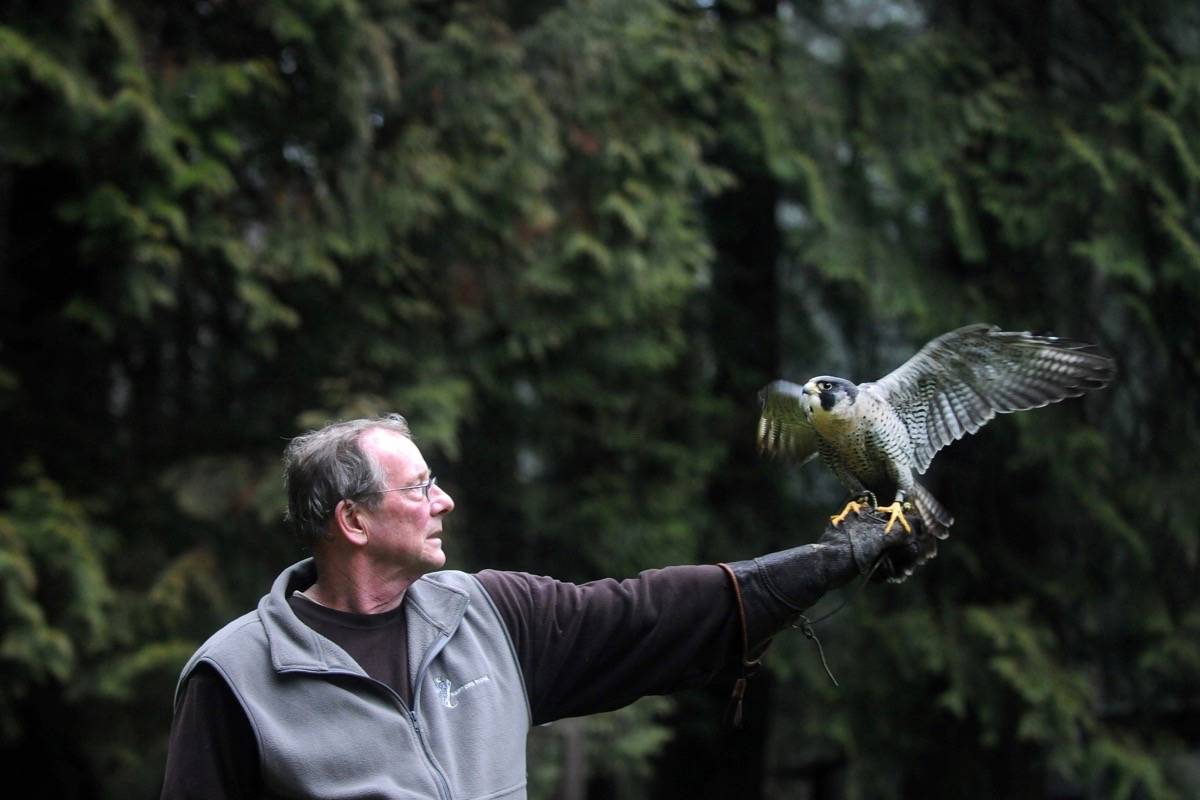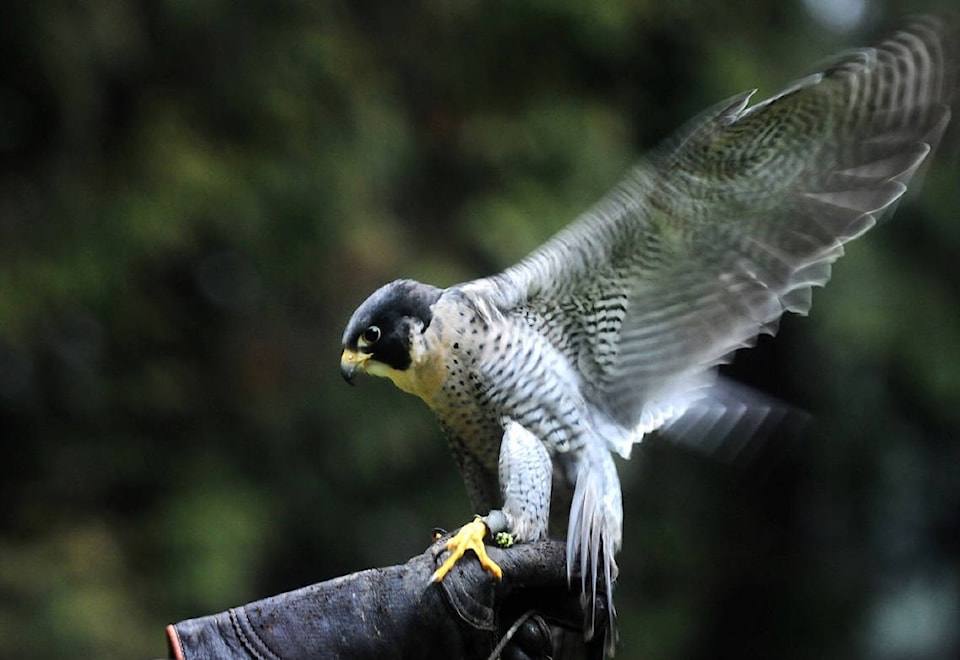Avro squawks as he is taken out of his cage at his Thornhill-area home, Raptors Ridge Birds of Prey.
The male peregrine falcon is perched upon falconer Kim Kamstra’s hand, which is protected by a full-cuff glove.
A string tied to the glove and attached to the anklets on Avro’s legs restrains the raptor as he looks about.
Avro is resting after a six-week long job with TransLink, for which he was used to frighten away pigeons from SkyTrain stations along the Expo and Millennium lines.
Peregrine falcons catch medium-sized birds by diving from high perches called stoops, reaching speeds of up to 320 km/h, and are well known to be experts at catching pigeons, according to Cornell University.
A peregrine is most likely to be seen in a cityscape as opposed to other falcons. They typically nest on tall structures. In Canada, peregrines are found mostly along the West Coast and in the northern tips of Nunavut, the Northwest Territories and Yukon.
Kamstra, who owns Raptors Ridge with his wife Karen, spent three days a week, eight hours a day randomly targeting the six SkyTrain stations, which included Burrard and 22nd Street on the Expo Line and Renfrew, Rupurt, Holdom and VCC Clarke along the Millennium Line.
During the six-week pilot project, Avro, along with a saker falcon named Gilligan and a Harris hawk named Tony, were alternately tethered to Kamstra or his assistant as they walked the perimeter of the SkyTrain stations. The raptors were never released to catch the pigeons. They were only used to frighten them.
“We’re just seeing how the pigeons react to different raptor species,” said Kamstra.
Pigeons breed all year long compared to a peregrine falcon, which only breeds once a year. About 70 per cent of pigeons will survive their first year compared to 20 per cent of peregrines.
“So there’s no way the wild numbers of peregrines can keep up with the numbers of pigeons being produced,” said Kamstra.
It takes little for a falcon to frighten pigeons.
Kamstra said that some stations had more than 100 pigeons that had habituated themselves in the surrounding area for as many as 30 years. However, after walking the perimeter with Avro for the six weeks, there were only about six or eight that remained.
“Some stations we even changed it in two and a half weeks,” he said.
Chris Bryan, with TransLink, said pigeons cause two main issues for SkyTrain and its users. Firstly, they trigger the intrusion lines on the system when they land on the tracks.
“Birds, in general, set off about 20 per cent of our intrusion line delays in 2017 and that’s a total of 142 train trips that were delayed by birds.”
Bryan added that at problematic stations, such as Renfrew, that number rises to 50 per cent.
There are two types of intrusion alarms on the SkyTrain tracks. One is a weighted alarm that is on the Expo Line.
On the Millennium Line, there are lasers that run the length of the platform down by the rails. The alarm is triggered when any of the lasers are cut off.
Also, at the end of the platforms there are lasers that go across to stop people from walking on the guide-way.
“A bird taking flight can go through that beam and set off the alarm in that fashion, as well,” said Bryan.
Usually, delays are fairly short, said Bryan, but SkyTrain attendants must inspect the track every time there is an alarm. They must ensure there is nothing on the track that could damage a train or that a person isn’t in that area.
“And being an automated system, we don’t always have staff at every station, at every platform all the time. Sometimes it means they have to come from an adjacent station. So it could take 10, 20 minutes before we get moving again,” he said.
Pigeons are also a public health issue.
“The guano from pigeons is known to contribute to three upper respiratory diseases and we want to try to reduce that risk as much as possible,” said Bryan.
“What many people don’t realize is if you measured the pigeon poop from 100 pigeons in the year, it’s about 4,800 pounds, and that’s the size of a three-quarter-tonne, full-sized pickup truck,” said Kamstra.
Pigeons are attracted to the stations for the usual reasons. Where there are a lot of people, there is discarded food.
Many people also feed the pigeons, which is discouraged through a public education campaign, including signs with reminders not to do so.
Kamstra said feeding pigeons can actually make them unhealthy. Furthermore, he added, food that isn’t eaten by the pigeons attracts rats.
“As soon as you have a rat problem, then people put out rodenticide, and when you put out rodenticide, you’re killing anything tertiary, secondary to that, like owls, hawks and stuff like that,” Kamstra said.
The number of birds the Orphaned Wildlife Rehabilitation Society in Delta receives each year from rodenticide poisoning is quite concerning, he said.
The cost of trial project was $18,000 for the six weeks.
Kamstra expects that the pigeons will slowly return to the stations in about two to three weeks.
But, Bryan said, they start to get the message that the stations are not a safe place for them.
“We see this as one tool in the tool kit. We have things like spikes on the tops of surfaces at stations. We have netting in some areas. We’ve even tried little sounds that mimic the sounds of predatory birds. They all work to some extent, but they’re not 100 per cent.”
Similar deterrents have been used in places like Granville Island and are considered successful.
Next, Bryan said, TransLink needs to look at how the intrusion alarms worked over the test period, and also look at customer complaints.
Then TransLink will decide whether to continue with the falcon program and decide what that will look like in terms of the structure, extent and who will provide the service.
In terms of the cost for the service, Bryan said there are about 470,000 boardings on SkyTrain on the average weekday.
“If we can reduce delays incurred by these [birds], it’s money well spent.”

